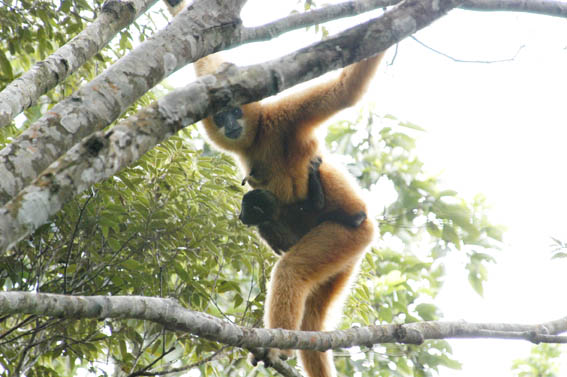It’s not easy to be a gibbon: although one of the most acrobatic, fast, and marvelously loud of the world’s primates, the gibbon remains largely unknown to the global public and far less studied than the world’s more ‘popular’ apes. This lack of public awareness, scientific knowledge, and, thereby, conservation funding combined with threats from habitat loss to hunting to the pet trade have pushed seven gibbon species, known as ‘crested’, to the edge of extinction according to scientists attending the 23rd Congress of the International Primatological Society.
“The crested gibbons are the most threatened group of primates and all species require urgent attention to save them from extinction”, Thomas Geissmann, gibbon expert from Zurich University and advisor with Fauna & Flora International (FFI), said in a statement
 A cao vit gibbon, a subspecies of the eastern black crested gibbon, in the new Bangliang Cao Vit Gibbon Nature Reserve. Photo by: Zhao Chao, FFI. |
Gibbons, who spend their lives in trees, have been dubbed the ‘lesser apes’, for while gibbons do not have a tail like other ape species—gorillas, chimps, and orangutans—they share some other characteristics with monkeys. The seven gibbon species of concern inhabit regions east of the Mekong, including Laos, Cambodia, Vietnam, and China.
The situation is bleakest for the eastern black crested gibbon. This species is not only the world’s most endangered gibbon, but likely the most endangered primate. Split into two subspecies—the cao vit and the Hainan—the eastern black crested gibbon has in total just over 100 individuals surviving. Only 20 or so Hainan gibbons survive in China, while the cao vit gibbon is faring just a little better.
“Current efforts by FFI appear to be turning round the fortune of the cao vit gibbon at the eleventh hour,” said Paul Insua-Cao, FFI China-Indochina Primate program manager, in a statement. “FFI has been championing conservation of several of the world’s rarest gibbon species for more than a decade. The organization is working with local communities and government authorities across the range states of these gibbons to protect them and their habitat”.
Of the seven species of crested gibbon, three are listed by the IUCN Red List as Critically Endangered, four are Endangered, and one is Vulnerable to extinction. One would be hard pressed to find another mammalian group so imperiled. In fact, two of the species—the eastern black crested gibbon and the western hoolock gibbon—appear on the world’s top 25 most endangered primates list.
New surveys in largely unexplored regions have found unknown populations of some gibbon species, yet the situation remains dire for many. Gibbon experts say more action is needed if these apes are to saved from extinction.

Hainan gibbon with infant. Photo by: Bill Bleisch, FFI.
Related articles
Humans push half of the world’s primates toward extinction, lemurs in particular trouble
(02/18/2010) Of the known 634 primate species in the world 48 percent are currently threatened with extinction, making mankind’s closes relatives one of the most endangered animal groups in the world. In order to bring awareness to the desperate state of primates, a new report by the International Union for the Conservation of Nature highlights twenty-five primates in the most need of rapid conservation action. Compiled by 85 experts the report, entitled Primates in Peril: The World’s 25 Most Endangered Primates, 2008–2010, includes six primates from Africa, eleven from Asia, three from Central and South America, and five from the island of Madagascar.

(09/24/2009) There are 200 Tonkin snub-nosed monkeys left in the world. The cao vit gibbon, however, is even worse off with only 110 individuals remaining, giving it the dubious honor of being the second most endangered primate in the world (the closely-related Hainan gibbon with only 17 individuals is likely number one). Both of these species—the cao vit gibbon and Tonkin snub nosed monkey—have received good news recently as new reserves in China and Vietnam have been created in part to aid their survival.
(12/25/2006) White-handed gibbons in Thailand use songs as a defense against predators according to a study by researchers at the University of St Andrews in Scotland and the Max Planck Institute in Germany.








